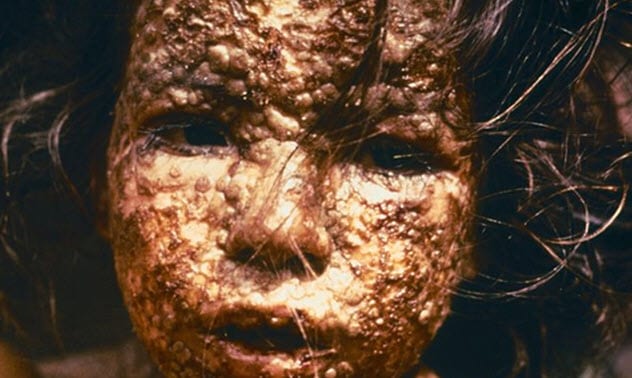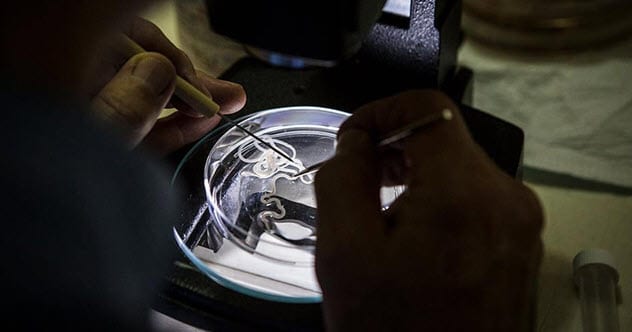 Creepy
Creepy  Creepy
Creepy  Technology
Technology 10 Scientific Breakthroughs of 2025 That’ll Change Everything
 Our World
Our World 10 Ways Icelandic Culture Makes Other Countries Look Boring
 Misconceptions
Misconceptions 10 Common Misconceptions About the Victorian Era
 Mysteries
Mysteries 10 Strange Unexplained Mysteries of 2025
 Miscellaneous
Miscellaneous 10 of History’s Most Bell-Ringing Finishing Moves
 History
History 10 Great Escapes That Ended Right Back in Captivity
 Weird Stuff
Weird Stuff 10 Fascinating Things You Might Not Know About Spiders
 Food
Food 10 Everyday Foods You Didn’t Know Were Invented by the U.S. Military
 History
History 10 Odd Things Colonial Americans Kept at Home
 Creepy
Creepy 10 More Representations of Death from Myth, Legend, and Folktale
 Technology
Technology 10 Scientific Breakthroughs of 2025 That’ll Change Everything
 Our World
Our World 10 Ways Icelandic Culture Makes Other Countries Look Boring
Who's Behind Listverse?

Jamie Frater
Head Editor
Jamie founded Listverse due to an insatiable desire to share fascinating, obscure, and bizarre facts. He has been a guest speaker on numerous national radio and television stations and is a five time published author.
More About Us Misconceptions
Misconceptions 10 Common Misconceptions About the Victorian Era
 Mysteries
Mysteries 10 Strange Unexplained Mysteries of 2025
 Miscellaneous
Miscellaneous 10 of History’s Most Bell-Ringing Finishing Moves
 History
History 10 Great Escapes That Ended Right Back in Captivity
 Weird Stuff
Weird Stuff 10 Fascinating Things You Might Not Know About Spiders
 Food
Food 10 Everyday Foods You Didn’t Know Were Invented by the U.S. Military
 History
History 10 Odd Things Colonial Americans Kept at Home
Top 10 Infectious Diseases Man Has Triumphed Over
Amid a global outbreak, it is easy to forget that humanity has triumphed over many diseases that used to devastate entire countries. Today, vaccinations are estimated to save three million people from death every year across the globe.
A few diseases have even been eradicated (gone forever), with even more eliminated (gone from entire countries or regions). Although we have a long way to go, it is comforting to look back on where we’ve been. Here are 10 of the greatest triumphs of modern science over bacteria, viruses, and parasites.
10 Infectious Diseases That Changed History
10 Smallpox

Smallpox was an airborne virus that killed roughly one-third of the people who contracted it. There is no cure, so doctors simply waited about two weeks to see if the patients died. If they were lucky enough to survive, they were permanently scarred from the iconic red pustules that give the disease its name.
In 1796, a British physician named Edward Jenner noticed that people who had cowpox when they were younger never seemed to catch smallpox. To test this theory, he injected the eight-year-old son of his gardener with cowpox before exposing the kid to the deadly smallpox virus. Surprisingly, it worked. Jenner had stumbled upon the world’s first vaccine.[1]
His discovery significantly reduced the number of deaths from the disease. By the time the World Health Organization (WHO) announced its plan to eradicate smallpox in 1959, the disease was restricted to South America, Africa, and Southeast Asia.
WHO ordered massive amounts of vaccines and instructed local governments on how to administer them. In 1977, the final recorded case of smallpox was seen in Somalia. As a result, WHO officially announced in 1980 that smallpox was the first disease ever to be eradicated by human intervention.
9 Rinderpest

Rinderpest (aka “cattle plague”) did not infect humans but was still devastating. In the 1890s, an outbreak killed 80–90 percent of all cattle in sub-Saharan Africa. Those who depended on these animals for meat, milk, and farmwork starved to death. The population of affected areas was reduced by at least one-third.
Any animal that survived the disease would never get rinderpest again. Also, the high death rate meant that wild animals (such as buffalo or giraffes) with rinderpest were wiped out before they could pass the virus to domestic cattle.
In the 1960s, a British scientist named Walter Plowright developed a vaccine, which the United Nations Food and Agriculture Organization started buying in bulk in the 1990s. Thousands of veterinarians across Europe, Asia, and Africa participated in vaccinating cattle and finally succeeded in wiping out rinderpest in 2011. It is the second disease to be eradicated.[2]
8 Polio

Polio, short for poliomyelitis, is a virus that paralyzes its victims. Sometimes, the paralysis is temporary. Other times, it causes permanent disability. Worst-case scenario, it spreads to the lungs and the patient dies.
In 1953, Jonas Salk announced that he had developed a vaccine for polio. He refused to patent his discovery in order to get it to as many people as possible. As a result, he forfeited billions in today’s US dollars.
The March of Dimes funded a large-scale trial of the vaccine before it was mass-produced for the US public. In 1979, only 24 years after the vaccination was formally introduced, the United States was declared polio-free.
To eliminate polio worldwide, WHO created the Global Polio Eradication Initiative in 1988. Between 1980 and 2016, there was a 99.99 percent decrease in cases. Currently, polio is only seen in Afghanistan, Pakistan, and Nigeria.[3]
7 Guinea Worm

When a person drinks stagnant water contaminated with Guinea worm larvae, the worms travel down to the intestines to mate. After 10–14 months, the female worm migrates as far as the human foot. There, she creates a painful skin lesion that drives the host to soak his foot in a pond or river, which releases the larvae into the water. From there, the cycle repeats.
Despite the painful lesions and the potential for bacterial infection, Guinea worm is rarely deadly. But as a general rule, people prefer not to have worms reproducing in their intestines.[4]
The Carter Center is leading the charge to use water purification to prevent the spread of Guinea worm. So far, it’s been incredibly successful. McGill University estimates that there were 3.5 million cases in 1986 throughout South Asia, Yemen, and sub-Saharan Africa. In 2018, there were 28 reported cases worldwide.
6 Yaws

Yaws (aka frambesia) is caused by skin-to-skin contact with the bacterium Treponema pallidum pertenue. Within three months of being infected, the patient will develop raspberry-like lesions on his skin, especially his face. These vanish within six months, only to erupt again later and leave scarring. Humans being humans, these scars can lead to bullying and discrimination.
In the 1950s, yaws was endemic in over 70 countries. Since it is easily cured with a single dose of the antibiotic azithromycin, it was one of the first diseases targeted by WHO for eradication. Yaws was almost wiped out in the 1960s, but smallpox received more attention and interest fell in yaws. In 2019, yaws was still present in 15 countries.[5]
10 Diseases That Prevent Other Diseases
5 Hookworm

Hookworms, which live in sewage-contaminated soil and enter through the patient’s feet, travel up to the small intestine where they drink their victim’s blood. From there, they cause lethargy, anemia, bloating, and stunted growth.
As they live in areas with poor sewage treatment, the patient often poops them out and the hookworms end up in the ground again. From there, they find new feet to invade.[6]
In 1910, John D. Rockefeller Sr. donated $1 million to eradicate hookworms in the American South. After a five-year campaign, infection rates were significantly reduced. Even better, more kids were showing up to school and actually paying attention because they didn’t have worms sapping their energy.
Despite the near elimination of hookworms, there is a high rate of reinfection and the worms can reappear. To conquer hookworms once and for all, the Human Hookworm Vaccine Initiative is creating a drug that interrupts the worm’s ability to eat. Soon, they might be gone for good.
4 Measles

Yes, this one has made a bit of a comeback in recent years because people haven’t continued to vaccinate against it. But globally, measles cases have been drastically reduced in the past 50 years.
Before 1963, just about every child in the United States got measles before age 15. Major epidemics occurred every 2–3 years, with an average of 2.6 million deaths every year due to the disease. It is passed through coughing and sneezing.
In 1954, Dr. Thomas C. Peebles of Harvard University asked sick, 11-year-old David Edmonston if he wanted “to be of service to mankind.” David let the doctor swab his measles-infected throat. Physician John F. Enders was able to isolate the virus from his sample and created the Edmonston-Enders vaccine that is still used today.[7]
Between 2000 and 2018, measles deaths dropped 73 percent thanks to mass vaccination, saving an estimated 23.2 million people. Even in the United States (where measles was eliminated in 2000), only 1,282 cases appeared in 2019.
3 Tetanus

Tetanus is caused by the bacterium Clostridium tetani, which lives in soils all over the world. The bacteria enter the body through an open wound, where they release a toxic chemical that causes paralysis and painful muscle contractions.
As C. tetani is resistant to chemicals and heat, tetanus is unlikely to be eradicated. But it can be eliminated (no new cases) through mass vaccination. So far, efforts have been incredibly successful.
In 1990, 314,000 people died of tetanus worldwide. In 2017, there were only 38,000 deaths. That’s an 88 percent decrease. The highest numbers of cases are in South Sudan and Somalia.[8]
2 Elephantiasis

Elephantiasis is caused by three species of threadlike worms that lodge in their victim’s lymphatic system. This disrupts the body’s ability to regulate liquids, which can cause the infected limbs or genitals to swell to elephant-like proportions.
While the worms are in the lymph nodes, they release larvae into the bloodstream. So, if a mosquito bites someone with elephantiasis, it passes the disease to the other people it bites.
Certain medications can be used to treat the illness. Combined with precautions against mosquitoes, this can stop the spread of the disease.
Since 2000, at least 7.7 billion treatments have been delivered to more than 910 million people. Sixteen countries have eliminated elephantiasis, and seven more are under surveillance to see if they can make the list.[9]
1 Malaria

Malaria is caused by a small parasite in the blood that is spread by mosquitoes. Symptoms include fever, chills, headache, nausea, and body aches. Although the disease continues to infect people across the world, humanity has made enormous leaps in combating it.
Malaria has been endemic in Europe, Africa, and Asia since time immemorial. When Europeans colonized North and South America, the disease hitched a ride. Historians estimate that, at the height of the disease, inhabitants across 53 percent of the world’s landmass faced the risk of contracting malaria.
In the United States and Europe, the 1900s brought new understanding as to how malaria spread. Wetlands, where mosquitoes bred, were drained or filled in. Insecticides were mass sprayed. One organization, the Office of Malaria Control in War Areas, later became the Centers for Disease Control.
The 21st century has been incredibly productive in the fight against malaria. Between 2000 and 2015, the number of malaria deaths dropped from 840,000 a year to 440,000. Most of those who died were children in Africa.[10]
10 Surprising Facts About The Spread Of Disease








